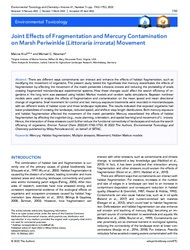Joint Effects of Fragmentation and Mercury Contamination on Marsh Periwinkle (Littoraria irrorata) Movement
Krull, Marcos
Newman, Michael C.
DOI: https://doi.org/10.1002/etc.5351
Persistent URL: http://resolver.sub.uni-goettingen.de/purl?gldocs-11858/10258
Persistent URL: http://resolver.sub.uni-goettingen.de/purl?gldocs-11858/10258
Krull, Marcos; Newman, Michael C., 2022: Joint Effects of Fragmentation and Mercury Contamination on Marsh Periwinkle (Littoraria irrorata) Movement. In: Environmental Toxicology and Chemistry, Band 41, 7: 1742 - 1753, DOI: 10.1002/etc.5351.
 |
Dokument öffnen: |
There are different ways contaminants can interact and enhance the effects of habitat fragmentation, such as modifying the movement of organisms. The present study tested the hypothesis that mercury exacerbates the effects of fragmentation by affecting the movement of the marsh periwinkle Littoraria irrorata and reducing the probability of snails crossing fragmented microlandscape experimental systems. How these changes could affect the search efficiency of organisms in the long term was assessed using hidden Markov models and random walks simulations. Bayesian nonlinear models were used to analyze the effects of fragmentation and contamination on the mean speed and mean directional change of organisms. Snail movement for control and two mercury‐exposure treatments were recorded in microlandscapes with six different levels of habitat cover and three landscape replicates. The results indicated that exposed organisms had lower probabilities of crossing the landscape, reduced speed, and shifts in step length distributions. Both mercury exposure and habitat fragmentation affected the movement of the marsh periwinkle. Mercury exacerbated the effects of habitat fragmentation by affecting the cognition (e.g., route planning, orientation, and spatial learning) and movement of L. irrorata. Hence, the interaction of these stressors could further reduce the functional connectivity of landscapes and reduce the search efficiency of organisms. Environ Toxicol Chem 2022;41:1742–1753. © 2022 The Authors. Environmental Toxicology and Chemistry published by Wiley Periodicals LLC on behalf of SETAC.
Statistik:
ZugriffsstatistikSammlung:
This is an open access article under the terms of the Creative Commons Attribution‐NonCommercial License, which permits use, distribution and reproduction in any medium, provided the original work is properly cited and is not used for commercial purposes.

